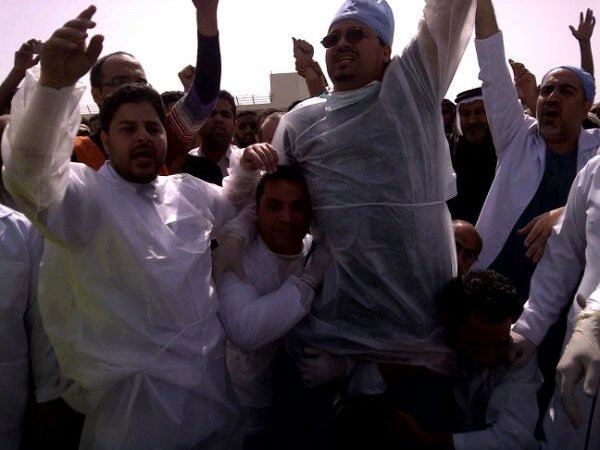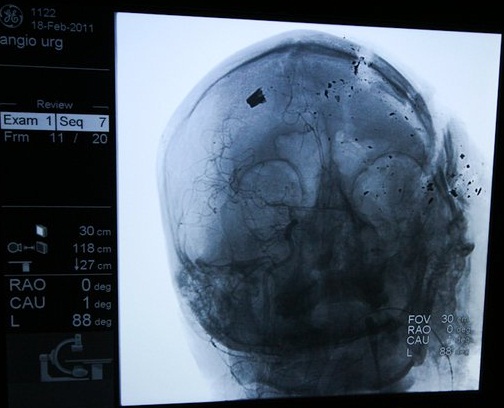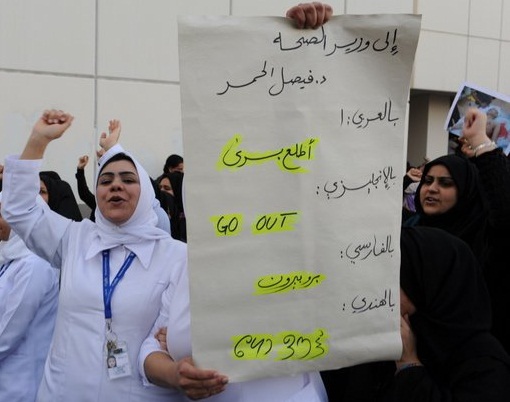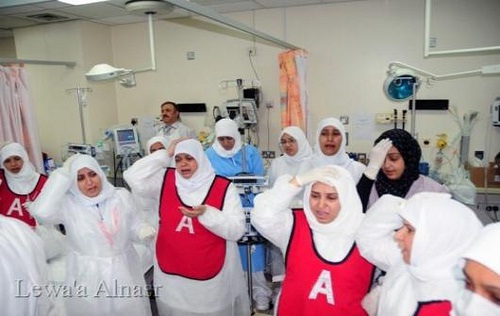Bahraini Doctors: A Thorn to the Regime - part 2

2011-07-01 - 11:40 ص
Bahrain Mirror (Exclusive): Had the morning of Feb 17 ended yet? “How long and disastrous it was! We thought it would never end because of the horrific events we experienced!” One of the medical staff said.
The surprise attack that the security forces launched against the peaceful protesters in the Pearl Roundabout shocked everyone. Even the regime loyalists found it difficult to justify the attack.
After an “official” silence of twelve hours, the Ministry of Interior aired its version of the events. That narrative was not able to manipulate the international public opinion. The government, deliberately, showed bloody and gruesome injuries of memebers of the security forces which had been inflicted on them by the protesters, as Bahrain TV said. The international public opinion only found it as a futile attempt to justify a brutal attack.
“Once we watched the regime official version on Bahrain TV, we realized that the Ministry of Interior and Bahrain TV had staged out the scenes of that story during the period from 6:30 to 11:30am. When we were finally allowed to reach the roundabout several hours after the attack, everything had been, bizarrely, cleared. They had sarcastically said to us: see everything you had heard was just hype” A medical staff said.
Another said: ”We reached in a number of ambulances, the anti-riot police banged on the ambulances with iron rods to scare us. They stopped us frequently at every checkpoint. They opened the ambulances and checked them. They cynically asked us where the injured were? They investigated our identities in a humiliating manner”.
The Shocking Army
Another shock that was not understood by the people was the deployment of the military troops on the streets. Bahrain Defense Force issued a statement it dubbed "Statement Number 1" and declared that it had deployed troops in the Capital Governorate to maintain security and safety for citizens and residents and it stressed on taking all stringent and deterrent measures to enforce security and order.
A female doctor surprisingly said “It's the first time we've seen military armored vehicles roam the streets in Bahrain. The goal was not to fight an external enemy, but peaceful unarmed protesters were sleeping in the roundabout” What nobody understood then was “Why the army?” and why was that sudden brutal attack after just 48 hours since the King had expressed his regret for the fall of the two victims, declared a day of a mourning, and formed fact-finding committee.
The sock was beyond everyone's grasp. They were bewildered by what happened: the politicians, the lawyers, the professionals, the media people, the intellectuals, and the civiic bodies. The medical staff was in more amazement. In addition to the shocking event, they were witnessing the painful screams of the inured and the tragedy of the killed ones. The doctors found themselves more than the others in the middle of the event. “Their presence in this event was normal as it was their professional duty to attend to the injured, let alone the humanitarian obligation” An observer said.
Salmaniya Hospital became, again, the focus of the events. The Emergency Department courtyard turned into a square for the agitated people. The hospital administration was not able, again, to control the crowding people.
The long day ended with the death of four protesters: Mahmood Abu Taki (21 Years) and Ali Khudair died because of birds gunshots, Isa Abdulhassan died of a direct shot that was aimed at his head, and Ali AlMomen who died by birds gunshots that hit his pelvis and cut his vessels (the consultant Dr. Sadeq Abdulla's attempts did not save him, neither the thirty blood bags were able to restore his pulse).
The day ended, also, in dozens of wounded men, women and children, with different injuries that ranged from medium to severe ones.
The Doctors Demonstration
 |
A number of doctors met in one of the doctors' homes. The objective was to stage a sit-in in the parking space of Salmaniya Hospital and issuing a bulletin expressing the opinions of the medical staff. The bulletin denounced the attacks that the security forces launched against the medical staff while they were performing their humanitarian mission, and to bring to account and sacking of the Minister of Health Mr. Faisal AlHamar and the administrative staff working with him.
In the afternoon, the sit-in started. There were 2000 participants from the medical staff as quoted by one of the participants. The large number of the participants and the intense enthusiasm that overtook them turned the sit-in into a demonstration that marched three times in the hospital parking space. The sit-in ended. And the closing statement was read. But things did not end there.
Dr. Ali AlEkri asked the medical staff to go back to where they worked without giving much explanation. One of the female doctors remembered: “While we were in our last march of the demonstration we heard the sounds of gunshots. What was happening?”.
Bare Chests and Armors
While the doctors were about to finish reading their bulletin, in Daih village (2km to the west of the Pearl Roundabout) a ceremony was taking place to close the three-days mourning for the first victim in the revolution Ali Mushaima'a. The mourners marched in thousands in a demonstration heading to the roundabout that was besieged by security and military troops. A number of the youngsters carrying the Bahraini flag advanced toward the military vehicles that were blocking the way the to the roundabout and stopped only a hundred meters from them. They waved the flags with unarmed hands. Moments passed, and then the scene that the world would see in video took place. A barrage of live bullets and tear gas poured on them. After the smoke had settled, several people were lying in ponds of their blood.
The medical staff heard those shots. Some of the staff was frightened and left and the rest immediately went inside the hospital to be ready to offer their assistance to the injured that the ambulances started to transfer. Another medical alert started.
The youth participating in the mourning march hurried to Salmaniya Hospital with the injured in their cars. One of the eye witnesses said: “I was there when I saw dozens of the young people flocking to the hospital in horror and bewilderment; they organized the traffic to ease the movement of the ambulances at the entrance of the hospital. I inquired about that. They told me that live rounds of bullets had been fired against those mourners leaving from the martyr Ali Mushaima'a mourning and heading to the Pearl Roundabout. There was a large number of the injured lying on the ground in the way to the roundabout”.
Another female eyewitness said: “Many youngsters were going out of the Emergency Department gate moving gurneys to transfer the injured from private cars that brought them”.
Adulredha's Bullet
While blood was being shed on the street leading to the roundabout, the Crown Prince surprised everyone by an unexpected visit to the Bahrain TV studio. He improvised a speech. “I offer my condolences to all Bahrainis for the painful days we live. I request everybody to calm. We need some time to evaluate what has happened and to reunite and regain our humanity, civiliity and future prospects. Today we are at crossroads. Some sons go out believing that they have no future in this country. Others do it out of love and keenness toward the country achievements. But this country is for everyone, not for a group on the expense of the other. Neither for Sunnis, nor for Shiites. It's for Bahrain and the Bahrainis. In these moments all decent people should say enough to what we have lost in these days. It's difficult to get that back, but I trust the efforts of those who are sincere”.
 |
In Salmaniya Hospital, there was no space for calm. There was only overwhelming chaos and indignant agitation. The scenes of bullets and blood of the injured that kept flowing in had only the scent of murder and death. Thousands massed and hysterically chanted slogans calling for the downfall of the regime. The paging system in Salmaniya Hospital urged all the doctors to go to the operations and emergency rooms. “This time the situation was more catastrophic. We had to deal with live bullets. We didn't believe it could have reached this far. It was a terrifying experience that we hadn't dealt with before. We didn't know if we were able to handle such cases or not” One of the medical staff said.
The most difficult case was that of Mr. Abulredha Buhmaiyed (32 years). A bullet penetrated his head. The consultant Dr. Nabeel Hameed tried to rescue him. A surgical operation continued for three hours, but failed to extract the bullet from his skull. The consultant Dr. Nehad AlShirawi worked to follow-up his case. Abulredha remained clinically dead for two days. He passed away on February 21. Before that Dr. AlShirawi collapsed in a fit of weeping in front of the cameras. Later she would pay the price of that weeping in the martial tribunal.
The number of injuries reached 96, some of them were hit by live bullets, six were admitted to the operations room, as declared by medical sources then.
Another female medical staff said: “We were shocked by the cases that had come to us. Bullets were in vital parts: in the chest and head. Direct shots of rubber bullets, birds gunshots, and live bullets, were deliberately shot to strike vital parts like the eye and the chest, sixty cases since the start of the events. Some lost one eye and others both of the eyes”.
The doctors deployed around the hospital: some treated the tear gas injuries, others worked in the recovery room, and the remaining were in the operations room.
The consultant Dr. Basem Dhaif treated three cases. Two were injuries in the femur and the third was a severe injury in the ankle. The medical staff saw Dr. Basem deeply moved. They asked him as it was the first time they saw him cry. He replied: “I was not exposed to such violence in Bahrain”.
The female consultant Dr. Badria Toorani treated a case where a bullet had been lodged at the top of the thigh and close to the pelvis. Dr. Basem Mirza assisted her. They x-rayed the bullet. A group of journalists reached the hospital. They asked to see the cases in the recovery room. Dr. Basem Dhaif showed them the x-ray that displayed the bullet that had been extracted. But he said: “It was not me who treated this case”. The journalists asked for the bullet to photograph. They were told that it had been put in a bag and was secured. But where had it gone? One said “It was put in a bag and given to the human rights organization”
The Minister Lies
 |
Thousands gathered at Salmaniya Hospital Emergency courtyard till late at night. They angrily chanted the downfall of the regime. The social media networks broadcast video clips of those protesters. The international media was present and aired the scenes over its channels. The Ministry of Health represented by its Minister was not able to do anything. Everything was out of control, but the minister Mr. Faisal AlHamar did not convey such a picture. In an interview with Bahrain TV in that same evening, he said that the situation in Salmaniya Hospital had been stable and those who still needed medical care were decreasing and after scrutinizing the number and degree of the injuries, it had been found that there had been seven light injuries and they had been dealt with properly and would leave hospital soon. He added that there had been some citizens present at the Salmaniya Hospital outer courtyard, who had been merely the injured relatives. He affirmed that the security situation was under control and the scene at the hospital was calm.
That statement angered the doctors who found the Minister not competent to be a Minister of Health, a position that required honesty and honor. The doctors decided to issue a statement on behalf of the two medical societies: The Doctors Society and the Dentists Society, to denounce the excessive violence that had been used against the peaceful demonstrators. It denounced the Minister's statement in the media to limit the injuries in seven light injuries, which was absolutely far from reality where the number of the injured exceeded seven hundred, of them seven severe cases. There was one injury in the head and brain and one dangerous injury in the chest. All the cases had been caused by live bullets, birds gunshots, and brutal beatings by batons. The doctors demanded the minister's statements to be accurate and clear, and demanded his resignation.
On Saturday February 19, the Crown Prince ordered, in the afternoon, the immediate withdrawal of all the military forces from the streets. The troops besieging the roundabout withdrew. The protesters returned to renew their sit-in. It was then when a third stage of the doctors' experience began to unfold.
.
اقرأ أيضا
- 2024-07-10Bahraini Authorities Summon Head of Sanabis Ma'tam, Threaten "Actions" Due to Mourners' Chants Against Israeli Occupation
- 2024-07-10Political Prisoner Mohammad Al-Raml's Family Say He's Vomiting Blood Due to Poor Conditions, Fear for His Life
- 2024-07-09Ali Al-Majed Arrested After His Return to Bahrain
- 2024-07-08Yusuf Al-Muhafdha: Convicted Returnees to Bahrain Have the Right to a Lawyer, Retrial, and Legal Guarantees
- 2024-07-08Reciter Mahdi Sahwan: Head of Manama Police Informed Me of Ban on Reciters Traveling to Commemorate Ashura
